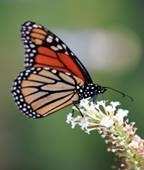Mon, Sep 14, 2009
Space Florida And BioServe Of Colorado Hope To Get Kids
Interested In Space Research
Space Florida and BioServe Space Technologies (based at the
University of Colorado), are providing an opportunity for 10
Florida elementary schools to participate in a unique International
Space Station (ISS)-bound life science investigation to launch
aboard Space Shuttle Discovery's upcoming mission (STS-129) in
November.

BioServe, a company that already develops a variety of hardware
and experiments for the ISS (many through Space Florida's Space
Life Sciences Laboratory (SLSL) at Kennedy Space Center),
approached Space Florida to help spread the word to Florida
elementary schools to generate their participation and select 10
schools to study differences in developing butterfly larvae on the
ground, versus those in microgravity aboard the ISS. Images from
the ISS space flight experiment will be downlinked daily, so that
participating students can observe the difference in results for
each test group of larvae. Classroom butterfly habitats will be
provided by BioServe's "Butterflies in Space" program.
The BioServe Commercial Generic Bioprocessing Apparatus (CGBA) will
be used to transport six-day old Vanessa cardui "Painted Lady
Butterfly" and 10-day old Monarch Butterfly larvae to the ISS, via
Space Shuttle Discovery. The butterfly larvae will be housed in a
habitat that provides a suitable living environment and permits
periodic examination of the organisms' life cycle and behaviors in
microgravity. The organisms will remain alive in space for the
duration of their life cycle - about one month.

Painted Lady Butterfly
The deadline for Florida schools to apply is September 30, 2009
and schools will be awarded on a "first come, first served" basis.
Interested Florida elementary schools should contact Space Florida
Education.
The "Butterflies in Space" investigation is being offered to
Florida Elementary students by Space Florida and BioServe to help
generate student interest in and promote their understanding of
space life science, technology, engineering and mathematics, as
well as increase their awareness of organizations that help promote
the space industry.
More News
Also: B-29 Superfortress Reunion, FAA Wants Controllers, Spirit Airlines Pulls Back, Gogo Galileo Van's Aircraft posted a short video recapping the goings-on around their reorganiz>[...]
Light Gun A handheld directional light signaling device which emits a brilliant narrow beam of white, green, or red light as selected by the tower controller. The color and type of>[...]
"The journey to this achievement started nearly a decade ago when a freshly commissioned Gentry, driven by a fascination with new technologies and a desire to contribute significan>[...]
"Our driven and innovative team of military and civilian Airmen delivers combat power daily, ensuring our nation is ready today and tomorrow." Source: General Duke Richardson, AFMC>[...]
Aircraft Conflict Predicted conflict, within EDST of two aircraft, or between aircraft and airspace. A Red alert is used for conflicts when the predicted minimum separation is 5 na>[...]
 Airborne 04.16.24: RV Update, Affordable Flying Expo, Diamond Lil
Airborne 04.16.24: RV Update, Affordable Flying Expo, Diamond Lil ANN's Daily Aero-Term (04.20.24): Light Gun
ANN's Daily Aero-Term (04.20.24): Light Gun Aero-News: Quote of the Day (04.20.24)
Aero-News: Quote of the Day (04.20.24) Aero-News: Quote of the Day (04.21.24)
Aero-News: Quote of the Day (04.21.24) ANN's Daily Aero-Term (04.21.24): Aircraft Conflict
ANN's Daily Aero-Term (04.21.24): Aircraft Conflict




